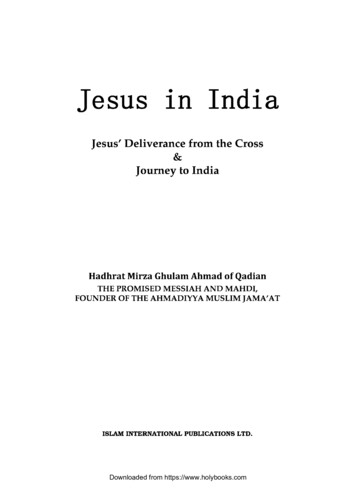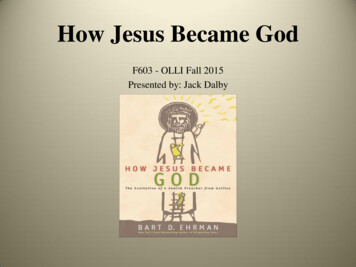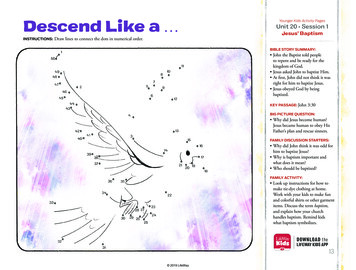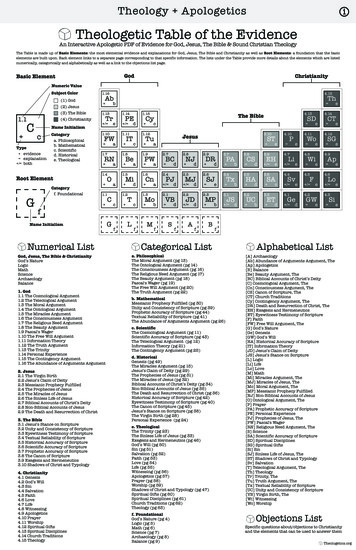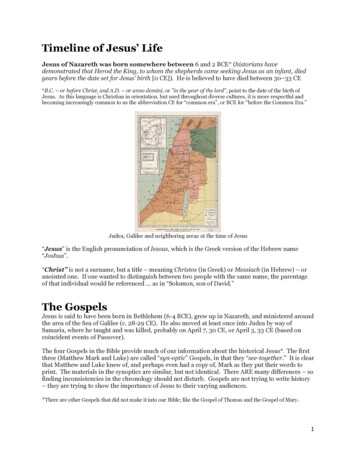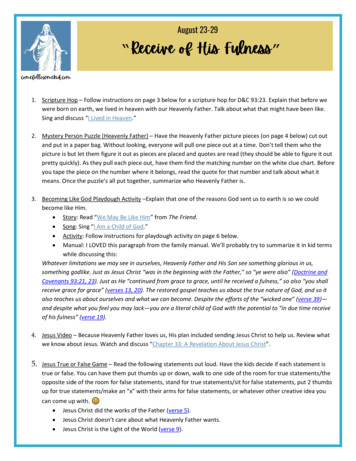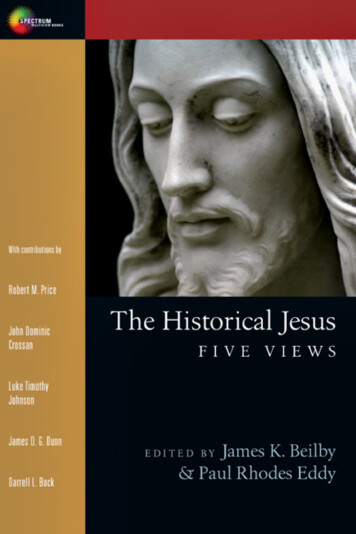
Transcription
InterVarsity PressP.O. Box 1400, Downers Grove, IL 60515-1426World Wide Web: www.ivpress.comE-mail: email@ivpress.com 2009 by James K. Beilby and Paul Rhodes EddyAll rights reserved. No part of this book may be reproduced in any form without written permission fromInterVarsity Press.InterVarsity Press is the book-publishing division of InterVarsity Christian Fellowship/USA , a movement of studentsand faculty active on campus at hundreds of universities, colleges and schools of nursing in the United States of America,and a member movement of the International Fellowship of Evangelical Students. For information about local andregional activities, write Public Relations Dept., InterVarsity Christian Fellowship/USA, 6400 Schroeder Rd., P.O.Box 7895, Madison, WI 53707-7895, or visit the IVCF website at www.intervarsity.org .Design: Cindy KipleImages: BigstockISBN 978-0-8308-7853-6 (digital)ISBN 978-0-9308-3868-4 (print)
CONTENTSThe Quest for the Historical Jesus: An Introduction . . . . 9Paul Rhodes Eddy and James K. Beilby1. Jesus at the Vanishing Point . . . . . . . . . . . .Robert M. Price55Responses:John Dominic Crossan . . . . . . . . . . . . . .84Luke Timothy Johnson . . . . . . . . . . . . . .89James D. G. Dunn . . . . . . . . . . . . . . . .94Darrell L. Bock . . . . . . . . . . . . . . . . .992. Jesus and the Challenge of Collaborative Eschatology . .John Dominic CrossanResponses:105Robert M. Price . . . . . . . . . . . . . . . . .133James D. G. Dunn . . . . . . . . . . . . . . . .143Luke Timothy Johnson . . . . . . . . . . . . . .Darrell L. Bock . . . . . . . . . . . . . . . . .3. Learning the Human JesusHistorical Criticism and Literary Criticism . . . . . . . .Luke Timothy JohnsonResponses:138148153Robert M. Price . . . . . . . . . . . . . . . . .178James D. G. Dunn . . . . . . . . . . . . . . . .188John Dominic Crossan . . . . . . . . . . . . . .Darrell L. Bock . . . . . . . . . . . . . . . . .183193
4. Remembering JesusHow the Quest of the Historical Jesus Lost Its Way . . . . .James D. G. DunnResponses:199Robert M. Price . . . . . . . . . . . . . . . . .226Luke Timothy Johnson . . . . . . . . . . . . . .239John Dominic Crossan . . . . . . . . . . . . . .Darrell L. Bock . . . . . . . . . . . . . . . . .5. The Historical JesusAn Evangelical View . . . . . . . . . . . . . . . . .Darrell L. BockResponses:233244249Robert M. Price . . . . . . . . . . . . . . . . .282Luke Timothy Johnson . . . . . . . . . . . . . .293John Dominic Crossan . . . . . . . . . . . . . .James D. G. Dunn . . . . . . . . . . . . . . . .Contributors . . . . . . . . . . . . . . . . . . . . .288297301Name and Subject Index . . . . . . . . . . . . . . . 303Scripture Index . . . . . . . . . . . . . . . . . .309
THE QUEST FOR THEHISTORICAL JESUSAn IntroductionPaul Rhodes Eddy and James K. BeilbyTwo millennia after his sojourn on earth, Jesus of Nazareth continuesto capture the attention of the contemporary western world like noother figure in history. This is no less the case for popular culture thanit is for the scholarly world, as his regular appearance in television specials and weekly news magazines attests. From the covers of Time,Newsweek and, yes, even Popular Mechanics, Jesus remains big news oninto the third millennium.1 Today, in the world of popular-level, pseudoscholarly publications on Jesus, there is no end to the provocative and/orconspiratorial theories available. In these one can find Jesus survivingthe crucifixion, getting married (most often to Mary Magdalene), having children and living to a ripe old age.2 Some even claim that theyhave finally found his gravesite—and with it the very bones of Jesus.3Or one can find him traveling to the East, spending years learningMike Fillon, “The Real Face of Jesus: Advances in Forensic Science Reveal the Most FamousFace in History,” Popular Mechanics, December 2002, pp. 68-71.2Michael Baigent, The Jesus Papers: Exposing the Greatest Cover-up in History (San Francisco:HarperSanFrancisco, 2006).3Simcha Jacobovici and Charles Pellegrino, The Jesus Family Tomb: The Discovery That WillChange History Forever (London: HarperElement, 2007).1
10The Histor ic a l Jesus: Fiv e Viewsfrom the ancient Asian religions, and coming back to his culture as something of a Buddhist master.4 Or, again, one can find out that the trueidentity of Jesus has finally been discovered: Jesus was really the apostlePaul!5The contemporary interest in Jesus within popular culture is, ofcourse, fueled by a parallel interest in the academic world. At the closeof the first decade of the twenty-first century, what has come to beknown as the third quest for the historical Jesus has been underway forthree decades and shows no sign of slowing down. This essay will begin with a relatively brief history of the modern scholarly “quest” for thehistorical Jesus. Next, important issues and debates within the currentphase—the “third quest”—will be explored. Finally, we will concludewith an introductory word about our five contributors to this volume.A B rief H istory of the Q uest for the H istorical JesusWhat has come to be known as the “quest for the historical Jesus” is achild of the eighteenth century and the European Enlightenment.6Prior to this, the notion of a “quest” for Jesus within the world of Western Christendom would have seemed a strange proposition. For, whilecertain tensions were apparent within and between the accounts of thefour canonical Gospels, they were still seen as able to be harmonizedHolger Kersten, Jesus Lived in India: His Unknown Life Before and After the Crucifixion (Rockport, Mass.: Element, 1994).5Lena Einhorn, The Jesus Mystery: Astonishing Clues to the True Identities of Jesus and Paul (Guilford, Conn.: Lyons, 2007).6Among the many helpful resources for reconstructing and interpreting the history of the questare the following: Charlotte Allen, The Human Christ: The Quest for the Historical Jesus (NewYork: Free Press, 1998); William Baird, History of New Testament Research: From Deism to Tübingen (Minneapolis: Fortress, 1992); Colin Brown, Jesus in European Protestant Thought, 1778–1860(Durham, N.C.: Labyrinth, 1985); Gregory W. Dawes, ed., The Historical Jesus Quest: Landmarksin the Search for the Jesus of History (Louisville: Westminster John Knox, 1999); James M. Robinson,A New Quest of the Historical Jesus (London: SCM, 1959); Bernard Brandon Scott, “From Reimarusto Crossan: Stages in a Quest,” Currents in Research: Biblical Studies 2 (1994): 253-80; W. BarnesTatum, In Quest of Jesus, rev. ed. (Nashville: Abingdon, 1999); William R. Telford, “Major Trendsand Interpretive Issues in the Study of Jesus,” in Studying the Historical Jesus: Evaluations of the Stateof Current Research, ed. Bruce Chilton and Craig A. Evans (New York: Brill, 1994); Gerd Theissenand Annette Merz, The Historical Jesus: A Comprehensive Guide, trans. John Bowden (Minneapolis:Fortress, 1998 [1996]); Walter P. Weaver, The Historical Jesus in the Twentieth Century, 1900 –1950(Harrisburg, Penn.: Trinity Press International, 1999); Ben Witherington III, The Jesus Quest: TheThird Search for the Jew of Nazareth (Downers Grove, Ill.: InterVarsity Press, 1997).4
The Quest for the Historical Jesus11and thus reliable.7 From such a perspective, the Jesus of history and theJesus of the Gospels were one and the same. There was no need to gosearching for Jesus when he could be easily found in the Gospels. Ittook the modern age and its skepticism of both biblical and ecclesiastical authority to ignite the quest for Jesus.Today the most commonly used schema for delineating the historyof the modern scholarly quest for Jesus recognizes four distinct stages:the “old” (or “first”) quest, the so-called “no quest” period, the “new”(or “second”) quest, and most recently the “third quest.” We will sketcheach of these below, highlighting the most influential persons and ideasto emerge in each stage.The old quest: From Reimarus to Schweitzer (1778–1906). Eversince Albert Schweitzer’s 1906 landmark survey of the (old) quest(translated into English as The Quest of the Historical Jesus), it has become common to mark the beginning of the quest with the publicationof the work of Hermann Reimarus in 1778. According to Schweitzer,Reimarus “had no predecessors.”8 This, however, is not quite accurate.Reimarus’s ideas about Jesus did not spring ex nihilo from his pen.The roots of the (largely German) old quest lie in seventeenth-centuryBritish and French deism and the biblical criticism to which it eventually gave rise. Deist critiques of the notions of divine revelation andmiracles fueled a growing skepticism toward the Gospels. An array ofearly modern thinkers such as Benedict Spinoza, Isaac La Peyrere,Richard Simon, Thomas Woolston, Peter Annet and Thomas Morgan laid the groundwork for what would eventually emerge as the mature historical-critical method.9Perhaps the clearest example of a precursor to Reimarus can be foundOn premodern Christian attitudes toward the Bible and its interpretive difficulties see Baird,History, pp. xiii-xix; Werner Kümmel, The New Testament: The History of the Investigation of ItsProblems, trans. S. McLean Gilmour and Howard C. Kee (Nashville: Abingdon, 1972), pp. 13-39;Craig Blomberg, The Historical Reliability of the Gospels, 2nd ed. (Downers Grove, Ill.: InterVarsityPress, 2007 [1987]), pp. 24-30.8Albert Schweitzer, The Quest of the Historical Jesus: A Critical Study of Its Progress from Reimarus toWrede, trans. W. Montgomery (New York: Collier/Macmillan, 1968), p. 26.9On the rise of the historical-critical method see Baird, History, part 1; Brown, Jesus, pp. 29-55;Roy A. Harrisville and Walter Sundberg, The Bible in Modern Culture: Baruch Spinoza to BrevardChilds, 2nd ed. (Grand Rapids: Eerdmans, 2002).7
12The Histor ic a l Jesus: Fiv e Viewsin the work of the British deist Thomas Chubb (1679–1746).10 In 1738Chubb published a book about Jesus, presenting him as “a sort of firstcentury Palestinian Deist, garbed in the seamless robe of reason andnatural religion.”11 Unfortunately, according to Chubb, much of thelater Christian dogma was later foisted on the deist-like Jesus of historyby the apostle Paul.Hermann Samuel Reimarus: The “Father” of the quest. Regardless of hisprecursors, however, Reimarus (1694–1768), a German professor of Semitic languages, took an original and significant step in the modernstudy of Jesus, and with it became the “Father” of the quest. Reimarusmoves beyond his deist predecessors in that he proposes a fleshed-outalternative account of Christian origins, one that situates Jewish apocalyptic thought at its center.12 Reimarus begins by arguing for a cleardistinction between the actual Jesus of history and the Gospels’ presentation of him.13 From Reimarus’s perspective just who was this historian’s Jesus? Simply put, “he was born a Jew and intended to remain one.”14More specifically, Jesus was a Jew who proclaimed the “kingdom ofGod,” by which, according to Reimarus, he must have intended “theusual meaning of this phrase among the Jews of his time”—i.e., a political kingdom centered in Jerusalem that would be established by theMessiah through the use of military force.15 And with this interpretivemove, Reimarus arrived at his famous conclusion: the real Jesus of history was a would-be Messiah figure who hoped to establish an earthlykingdom through revolutionary force—but these hopes were dashedwhen he was arrested and crucified. How then did the Christian faitharise? Reimarus’s answer is daring: Hoping to finally attain the richesIn fact, Charlotte Allen (Human Christ, p. 76) dignifies him with the title of “probably the originator of the quest for the historical Jesus.” On Chubb’s view of Jesus and/or his role as a precursor to the quest see Allen, Human Christ, pp. 76-80, 108-9; Baird, History, pp. 54-56; Brown,Jesus, p. 46.11Baird, History, p. 55.12On the deistic influence on Reimarus see Henk J. De Jonge, “The Loss of Faith in the Historicityof the Gospels: Hermann S. Reimarus on John and the Synoptics,” in John and the Synoptics, ed.,Adelbert Denaux (Leuven: Leuven University Press, 1992), pp. 409-21.13Hermann S. Reimarus, Reimarus: Fragments, reprint ed., ed. Charles H. Talbert, trans. Ralph S.Fraser (Chico, Calif.: Scholars Press, 1985), p. 64.14Ibid., p. 71.15Ibid., p. 124.10
The Quest for the Historical Jesus13and glory they had planned on receiving when Jesus became king, hisdisciples stole his body, fabricated a resurrection story and eventuallyconcocted “the doctrine of a spiritual suffering savior of all mankind.”16Reimarus wrote all of this and more, put the manuscript in his deskdrawer, and there it remained until he died. Concern for the consequences that might follow kept him from publishing it. Upon his death,his daughter gave the manuscript to a friend, the German literary criticGotthold Lessing, and gave him permission to publish it anonymously.This he did, claiming he had found the text in the Wolfenbüttel Library in Hamburg, and presenting it to the public in small sections(“fragments”) between 1774 and 1778. It was only many years later thatthe truth was revealed and Reimarus’s true identity discovered.Over the last few centuries only a few have concluded, similar toReimarus, that Jesus was in fact a politically minded revolutionary.17Nor have many agreed with him that Jesus’ disciples consciously intended to perpetrate a religious fraud for selfish gain. Rather, it is certain elements of his method that have continued to find relevance inlater stages of the quest. First, the firm line drawn by Reimarus between the Jesus of history and the Christ figure of the Gospels has remained an unquestioned presupposition for many scholars throughoutthe quest. Second, Reimarus raised a question that continues to behotly debated to this day: namely, what role, if any, does historical investigation of Jesus have to play within the context of the Christianfaith? Here Reimarus’s own answer is clear:Now, where the doctrine is not controlled by the history but vice versa,both history and doctrine are to this extent unfounded; the history because it is not taken from events themselves . . . ; and the doctrine because it refers to facts that originated in the writers’ thinking only afterthe doctrine was altered and which were simply fabricated and false.18Ibid., p.129.Those who have adopted this model in one form or another over the last century include RobertEisler, The Messiah Jesus and John the Baptist (London: Methuen, 1931); S. G. F. Brandon, Jesusand the Zealots (New York: Scribner, 1967); George Wesley Buchanan, Jesus: The King and HisKingdom (Macon, Ga.: Mercer University Press, 1984); Robert H. Eisenman, James the Brotherof Jesus: the Key to Unlocking the Secrets of Early Christianity and the Dead Sea Scrolls (New York:Penguin, 1998).18Reimarus, Fragments, p. 134.1617
14The Histor ic a l Jesus: Fiv e ViewsFinally, in setting Jesus firmly within the world of Jewish eschatology, Reimarus ignited a debate that continues raging to this day—thequestion of to what extent, if any, Jesus embraced views associated withfirst-century apocalyptic eschatology. Schweitzer, who likewise believed that Jewish eschatology held the key to understanding Jesus(though in a manner different from that argued by Reimarus), praisedReimarus at this very point.19Between Reimarus and Strauss: Early “ lives” of the old quest. Followinghis survey of Reimarus’s thought, Schweitzer turns in Quest of the Historical Jesus to consider what he dubs “the lives of Jesus of the earlierrationalism.”20 Names such as J. J. Hess, F. V. Reinhard, E. A. Opitz,J. A. Jakobi and J. G. Herder dominate this period. A characteristicfeature of these studies was an embrace, to one degree or another, of“rationalist” explanations of the Gospel materials.21 These early pioneers of the quest tended to place their emphasis on Jesus’ moral teachings and did their best to render him palatable to the more rational,“enlightened” thought of the times.The work of two scholars in particular is worth noting. In his fourvolume A Non-supernatural History of the Great Prophet of Nazareth(1800–1802), K. H. Venturini offers various “rational” explanations forthe reported miracles of Jesus. For example, Jesus’ miracles of healingare explained by the fact that Jesus was a proficient herbalist, alwaysaccompanied by his “portable medicine chest.”22 Adding a twist of conspiracy to things, Venturini also argues that Jesus, along with his cousinJohn the Baptist, was nurtured and groomed by a covert faction of theEssenes. Although undergoing crucifixion, Jesus only appeared to dieand was later revived in the tomb with the help of an Essene collaborator, Joseph of Arimathea.23 While few could take Venturini’s theoryseriously at the time, since the 1947 discovery of the Dead Sea Scrollsat Qumran and the attendant burst of interest in the ancient Jewish sectSchweitzer, Quest, p. 23.Schweitzer, Quest, pp. 27-37.21Ibid., p. 161.22Ibid., p. 44.23The idea that Jesus merely appeared to die on the cross—later dubbed the “swoon” theory—had already been proposed in 1744 by Peter Annet in his The Resurrection of Jesus Considered.1920
The Quest for the Historical Jesus15of the Essenes, Venturini-like theories have come to life again. Theyremain, however, generally the fruit of either eccentric scholars or nonacademic conspiracy theorists.24In the 1828 work of H. E. G. Paulus, The Life of Jesus as the Basis of aPurely Historical Account of Early Christianity, we find the epitome of theeighteenth-century “rationalist” approach to Jesus. Here Paulus famously does his best to explain the miraculous elements in the Gospelsas nothing more than the disciples’ mistaken interpretations of whatwere, in fact, purely natural events in the life of Jesus. And so, for example, the account of Jesus walking on the water is explained as something of an optical illusion—Jesus had been walking in the shallowwater off the shores of the Sea of Galilee, but from a distance it hadappeared to the disciples that he was farther out, and thus walkingupon the very waves themselves. From Paulus’s view, and in good liberal fashion, this approach should not in any way detract from theachievement of Jesus, since it is not his miracles but rather his admirable character that truly matters.D. F. Strauss: Jesus and “myth.” One of the most influential figures ofthe “old” quest is David Friedrich Strauss (1808–1874). His book The Lifeof Jesus Critically Examined, originally published in 1835, became one ofthe most controversial studies of Jesus ever written.25 Like his more robust rationalist predecessors, he was a thoroughgoing methodologicalnaturalist. But to Strauss’s mind, the rationalist attempts to explain theGospels as mistaken interpretations of historically occurring naturalphenomena entirely missed one of the most important elements of theWith respect to the former see John M. Allegro, The Dead Sea Scrolls and the Christian Myth (Buffalo: Prometheus, 1984); Barbara Thiering, Jesus and the Riddle of the Dead Sea Scrolls: Unlockingthe Secrets of His Life Story (San Francisco: HarperSanFrancisco, 1992). With respect to the lattersee, e.g., Michael Baigent and Richard Leigh, The Dead Sea Scrolls Deception (New York: Summit, 1991). For a survey and critique of various twentieth century claims that Jesus survived thecrucifixion see Gerald O’Collins and Daniel Kendall, “On Reissuing Venturini,” Gregorianum75 (1994): 241-65.25The Life of Jesus Critically Examined, ed. Peter C. Hodgson, trans. George Eliot (Philadelphia:Fortress, 1972). Strauss would go on to produce A New Life of Jesus, 2 vols. (London: Williamsand Norgate, 1865), which was intended for a wider, more popular readership. Then, within ayear, he would publish a critique of Schleiermacher’s (Strauss’s former teacher) book on Jesus:The Christ of Faith and the Jesus of History: A Critique of Schleiermacher’s The Life of Jesus, ed. andtrans. Leander E. Keck (Philadelphia: Fortress, 1977 [1866]).24
16The Histor ic a l Jesus: Fiv e ViewsGospels—namely the robust religious imagination of the early followersof Jesus and the expression of this imagination in the category of myth.In comparison to the theories of his predecessors, Strauss explains, theadvantage of the “mythical view” is that it “leaves the substance of thenarrative unassailed; and instead of venturing to explain the details, accepts the whole, not indeed as true history, but as a sacred legend.”26 AsSchweitzer notes, while Strauss was not the first to use the notion ofmyth to understand the Gospels, he applied this interpretive lens in amore ruthlessly consistent fashion than anyone before him.27Armed with this critical perspective, Strauss’s study of Jesus largelyconsists of analyzing the various contents of the Gospels with an eye tounmasking and explaining the many instances of myth containedtherein. Over and over again, Strauss concludes, early Christian imagination served to fabricate material about Jesus out of various Old Testament stories and concepts. In the end, all that was left for Strauss, historically speaking, was a small core of bare facts about Jesus.While the response to Strauss was swift and overwhelmingly negative—with some more conservative voices going so far as to claimthat he was the “antiChrist”—the impact of Strauss’s work on thequest is felt to this day, and he continues to function as something ofa patron saint for those who aspire to hard-nosed criticism of theGospels. 28 In several ways he anticipated important future developments in critical study of the Gospels. His consideration of the mythmaking process at work within the early oral Jesus tradition wouldeventually develop and mature, almost a century later, into the discipline of form criticism. His privileging of the category of myth wouldbe followed by the single most influential New Testament scholar ofthe twentieth century—Rudolf Bultmann. And his use of comparative non-Christian religious material foreshadowed the full floweringStrauss, Life, p. 56.Schweitzer, Quest, p. 79.28For example, Robert Funk and the Jesus Seminar dedicated their first major volume (The FiveGospels: The Search for the Authentic Words of Jesus [San Francisco: HarperSanFrancisco, 1993])to Strauss (along with Galileo and Thomas Jefferson). Funk’s Westar Institute has also created the “D. F. Strauss Medal” to honor scholars who have made significant contributions tothe study of Jesus, recipients of which include former Anglican Bishop John Shelby Spong andJohn Dominic Crossan.2627
The Quest for the Historical Jesus17of this method at the end of the nineteenth century in the Religionsgeschichtliche Schule (i.e., the old “history of religions school”) madefamous by Wilhelm Bousset and others.Finally, we can recognize in Strauss a quality that is both admirable and all-too-rare within the history of the quest: an explicitly statedself-consciousness concerning the religio-philosophical presuppositions that guide (both motivationally and methodologically) his critical study of Jesus. He was always quite forthright about the influenceof Hegel on his study of Jesus: “My criticism of the life of Jesus wasfrom its origin intimately related to Hegelian philosophy.” Equallyself-revealing is his comment: “I am no historian; with me everythinghas proceeded from a dogmatic (or rather anti-dogmatic) concern.”29Strauss has often been criticized for allowing his Hegelianism to infect his historical study of Jesus. And while this is a point well taken,no scholar has ever come to the quest free of philosophical presuppositions and religious (or antireligious, as the case may be) biases.What can be learned from Strauss here is that metacritical values andassumptions always already influence one’s historiographical philosophy and method, and that every Jesus scholar owes it to oneself andone’s fellow scholars both to be self-aware about these influences and,where appropriate, to explicitly state and defend them. We will pickup this issue again below.Between Strauss and Schweitzer: Later “ lives” of the old quest. Thenegative historical results and resultant skepticism of the Gospels displayed in Strauss’s Life of Jesus spurred a variety of reactions. At oneextreme, Bruno Bauer, taking his cue from Strauss’s critical methodology and concept of myth, pushed the thesis to its furthest possiblepoint and concluded that all was myth and nothing was history—Jesusnever was an actual person in history. 30 With this move Bauer becamea leading early proponent of the “Christ-Myth” theory, with otherslike Paul-Louis Couchoud, Arthur Drews and John M. Robertsoneventually following in his wake. 31 While Bauer’s Christ-Myth theCited in Brown, Jesus, p. 204.On Bruno Bauer see Schweitzer, Quest, 137-60; Brown, Jesus, pp. 227-31.31Paul-Louis Couchoud, “The Historicity of Jesus: A Reply to Alfred Loisy,” Hibbert Journal 372930
18The Histor ic a l Jesus: Fiv e Viewsory has had minimal impact on the scholarly quest, it captured theattention of Karl Marx and became a common feature of Soviet Marxist thought. 32In the face of such skepticism, others sought to shore up some basisfor the historical credibility of the Gospels. One effect of this effort wasthe rise of modern source criticism of the Gospels. During this time,the “two-source” theory of Gospel relations came to prominence—theview that Mark was written first and that, along with an early writtencollection of Jesus’ sayings labeled “Q” (from the German word Quelle,meaning “source”), was used by both Matthew and Luke in the composition of their Gospels.33 One of the attractive features of the twosource theory is that it allows Mark (with no embarrassing infancy narrative) and Q (sayings of Jesus without any narrative and thus withoutmiracles) to provide a generally reliable basis from which to reconstructthe life of Jesus. Though the two-source theory has always faced itschallengers, it remains to this day the most widely held solution to theinfamous “Synoptic Problem.”34While Schweitzer’s famous account of the old quest is largely focused on the German scene, other things were happening elsewhere. InFrance, Ernest Renan, an erstwhile Roman Catholic, produced his famous Life of Jesus in 1863, which went on to become a best-selling workwith multiple editions. Renan’s book presents a Jesus who began as awise teacher of ethical principles who reveals the loving character of theheavenly Father, but who, inspired by apocalyptic hopes, eventually became a would-be messiah who was crucified for his efforts. Like his(1938): 193-214; Arthur Drews, The Christ Myth, 3rd ed., trans. C. D. Burns (Amherst, N.Y.:Prometheus, 1998 [1910]); John M. Robertson, Christianity and Mythology (London: Watts,1900).32See Zvi Rosen, Bruno Bauer and Karl Marx: The Influence of Bruno Bauer on Marx’s Thought(The Hague: Nijhoff, 1977).33On the rise to prominence of the two-source theory see Baird, History, pp. 295-311.34For a defense of the theory, see Robert Stein, The Synoptic Problem: An Introduction (GrandRapids: Baker, 1987). For recent critiques of the two-source theory from different perspectives see Mark Goodacre and Nicholas Perrin, Questioning Q: A Multidimensional Critique(Downers Grove, Ill.: InterVarsity Press, 2005); A. J. McNicol, D. B. Peabody and L. Copeeds., One Gospel from Two: Mark’s Use of Matthew and Luke (Harrisburg, Penn.: Trinity PressInternational, 2002); Armin D. Baum, Der mündliche Faktor und seine Bedeutung für die synoptische Frage (Tübingen: Francke, 2008).
The Quest for the Historical Jesus19rationalist German counterparts, Renan denied any room for the supernatural in his reconstruction.One might raise the question here of why there are not more conservative voices in the choir of first questers? Part of the answer lies inthe fact that more conservative renderings of Jesus are short on newand daring proposals, following a course instead that is heavily dependent on the Gospel accounts themselves. In the history of the quest,old news (i.e., traditional conclusions about Jesus) is often regarded asno news. Beyond this, many of the more conservative studies of thistime were written as responses to the more radical proposals ratherthan as independent lives of Jesus. Be that as it may, from FredericFarrar and Alfred Edersheim in Britain to August Neander and August Tholuck in Germany, more conservative voices played a significant role in the ongoing European deliberations concerning the trueidentity of Jesus of Nazareth.35Culminating the old quest: Wrede and Schweitzer. As the nineteenthcentury drew to a close, the critical quest had left in its wake a wonderfully “liberal” Jesus—a Jesus stripped of the more unenlightenedentanglements associated with the Gospels and Christian orthodoxysuch as miracles and divine status. This Jesus was a moral reformer tobe sure, a teacher who revealed the fatherhood of God, the brotherhood of humankind, and the simple tenets of a reasonable, love-basedreligion. This Jesus, elaborated by such theological giants as AlbrechtRitschl and Adolf von Harnack, could still appeal to an enlightenedEuropean culture.As the new century dawned, however, two new voices served to cutthe ground from beneath this reasonable, ma
4Holger Kersten, Jesus Lived in India: His Unknown Life Before and After the Crucifixion (Rock-port, Mass : Element, 1994) 5Lena Einhorn, The Jesus Mystery: Astonishing Clues to the True Identities of Jesus and Paul (Guil-ford, Conn : Lyons, 2007) 6Among the many helpful resources for

